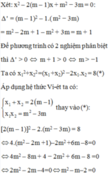
Hãy nhập câu hỏi của bạn vào đây, nếu là tài khoản VIP, bạn sẽ được ưu tiên trả lời.


Lời giải:
Để pt có 2 nghiệm thì $\Delta=(m-3)^2-4(-m+2)\geq 0$
$\Leftrightarrow (m-1)^2\geq 0$ (luôn đúng với mọi $m\in\mathbb{R}$)
Áp dụng định lý Viet:
$x_1+x_2=m-3$
$x_1x_2=-m+2$
$\Rightarrow x_1+x_2+x_1x_2=-1$
$\Leftrightarrow x_1+x_2+x_1x_2+1=0$
$\Leftrightarrow (x_1+1)(x_2+1)=0$
$\Leftrightarrow x_1=-1$ hoặc $x_2=-1$
TH1: $x_1=-1$
$x_2=\frac{-m+2}{x_1}=m-2$. Khi đó:
$x_1^2+x_2=8$
$\Leftrightarrow (-1)^2+(m-2)=8$
$\Leftrightarrow m=9$
TH2: $x_2=-1$
$x_1=\frac{-m+2}{x_2}=m-2$. Khi đó:
$x_1^2+x_2=8$
$\Leftrightarrow (m-2)^2-1=8$
$\Leftrightarrow (m-2)^2=9$
$\Leftrightarrow m-2=\pm 3\Leftrightarrow m=5$ hoặc $m=-1$

\(a,m=3=>x^2+3x-2=0\)
\(\Delta=3^2-4\left(-2\right)=17>0\)
pt có 2 nghiệm pb \(\left[{}\begin{matrix}x1=\dfrac{-3+\sqrt{17}}{2}\\x2=\dfrac{-3-\sqrt{17}}{2}\end{matrix}\right.\)
b,\(\Delta=m^2-4\left(-2\right)=m^2+8>0\)
=> pt đã cho luôn có 2 nghiệm phân biệt x1,x2 với mọi m
theo vi ét \(\left\{{}\begin{matrix}x1+x2=-m\\x1x2=-2\end{matrix}\right.\)
có \(x1^2x2+x2^2x1=2014< =>x1x2\left(x1+x2\right)=2014\)
\(< =>-2\left(-m\right)=2014< =>m=1007\)
a) Thay m=3 vào phương trình, ta được:
\(x^2+3x-2=0\)
\(\Delta=3^2-4\cdot1\cdot\left(-2\right)=9+8=17\)
Vì Δ>0 nên phương trình có hai nghiệm phân biệt là:
\(\left\{{}\begin{matrix}x_1=\dfrac{-3-\sqrt{17}}{2}\\x_2=\dfrac{-3+\sqrt{17}}{2}\end{matrix}\right.\)

Lời giải:
Để PT có 2 nghiệm $x_1,x_2$ thì:
$\Delta'=(m+1)^2-(m^2-1)>0\Leftrightarrow 2m+2>0\Leftrightarrow m>-1$
Áp dụng định lý Viet:
$x_1+x_2=2(m+1)$ và $x_1x_2=m^2-1$
Khi đó, để $x_1^2+x_2^2=x_1x_2+8$
$\Leftrightarrow (x_1+x_2)^2-2x_1x_2=x_1x_2+8$
$\Leftrightarrow (x_1+x_2)^2=3x_1x_2+8$
$\Leftrightarrow 4(m+1)^2=3(m^2-1)+8$
$\Leftrightarrow m^2+8m-1=0$
$\Leftrightarrow m=-4\pm \sqrt{17}$. Vì $m>-1$ nên $m=-4+\sqrt{17}$

\(\Delta'=\left(m-5\right)^2+2m-9=m^2-8m+16=\left(m-4\right)^2\ge0;\forall m\)
Pt đã cho luôn luôn có nghiệm
Theo hệ thức Viet: \(\left\{{}\begin{matrix}x_1+x_2=2\left(m-5\right)\\x_1x_2=-2m+9\end{matrix}\right.\)
Do \(x_1\) là nghiệm của pt nên:
\(x_1^2-2\left(m-5\right)x_1-2m+9=0\Rightarrow x_1^2=2\left(m-5\right)x_1+2m-9\)
Thay vào bài toán:
\(2\left(m-5\right)x_1+2m-9+2\left(m-5\right)x_2=4m^2\)
\(\Leftrightarrow2\left(m-5\right)\left(x_1+x_2\right)+2m-9=4m^2\)
\(\Leftrightarrow2\left(m-5\right).2\left(m-5\right)+2m-9=4m^2\)
\(\Leftrightarrow-38m+91=0\)
\(\Rightarrow m=\dfrac{91}{38}\)


Ta thấy các hệ số \(a,b,c\) của phương trình đã cho thỏa mãn \(a-b+c=1-\left[-\left(m-3\right)\right]-m+2=1+m-3-m+2=0\)
nên phương trình đã cho sẽ có một nghiệm là \(-1\) và nghiệm kia là \(m-2\).
Trong hệ thức \(x_1^2+x_2=8\), vai trò của \(x_1,x_2\) không như nhau nên ta xét 2 trường hợp:
TH1: Nếu \(x_1=-1\) thì \(x_1^2+x_2=8\Leftrightarrow\left(-1\right)^2+m-2=8\Leftrightarrow m=9\).
TH2: Nếu \(x_2=-1\) thì \(x_1^2+x_2=8\Leftrightarrow\left(m-2\right)^2-1=8\Leftrightarrow\left(m-2\right)^2=9\) \(\Leftrightarrow m-2=\pm3\) \(\Leftrightarrow\left[{}\begin{matrix}m=5\\m=-1\end{matrix}\right.\).
Vậy để phương trình đã cho có 2 nghiệm thỏa điều kiện đề cho thì \(\left[{}\begin{matrix}m=-1\\m=5\\m=9\end{matrix}\right.\)